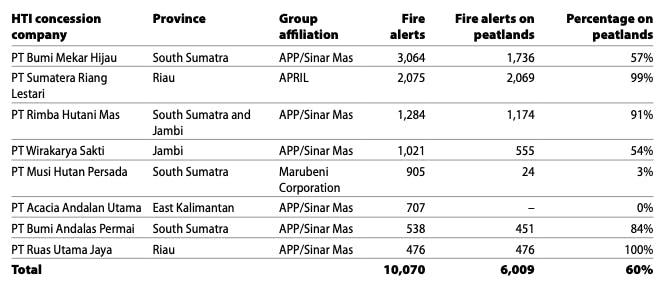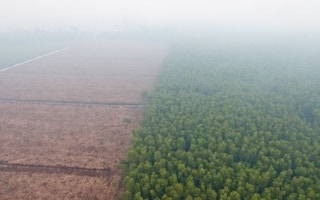A dangerous combination of the development of industrial palm oil and pulpwood plantations on Indonesia’s carbon-rich peatlands, and weakened regulations to protect peat, means that annual toxic haze outbreaks are likely to persist for many years to come, a new report from a coalition of non-government organisations (NGOs) has suggested.
Indonesia’s smallholder farmers tend to take most of the blame for the slash-and-burn forestry that causes the seasonal fires, which were the worst this year since the record-breaking haze of 2015. But the presence of multi-billion dollar agribusiness firms on fire-vulnerable peatlands drained for agriculture poses just as big a threat to these climate-critical areas, the report, titled Perpetual Haze: Pulp production, peatlands the future of fire risk in Indonesia, claims.
Cultivation of peat was made easier by a law passed by the Indonesian government in April 2019—the month that this year’s fires started in Indonesia—which environmentalists say weakened peatland protections introduced in the aftermath of the 2015 fires. That year, emissions from the fires over a three-week period surpassed the total annual CO2 emissions of Germany and reduced the life expectancy of hundreds of thousands of people in the region.
The new regulation rolled back the protection of areas outside of the thickest patches of peatland known as peat domes, enabling companies to exploit areas they were previously obliged to protect and restore.
The Perpetual Haze report claims that the revised peatland protection law—which was introduced a few months before the Indonesian government said that 80 per cent of burnt areas could be turned into oil palm plantations or other industrial crops—was partly the result of lobbying from industry.
According to the report, almost half of the fire alerts in the worst affected industrial plantation concessions in 2019 were located within areas that Indonesia’s Ministry of Environment and Forestry had previously designated as protected peatland.
The fires this year burned an area of more than 850,000 hectares—roughly 12 times the size of Singapore—in Kalimantan and Sumatra, and of the 41,000 fire alerts identified inside industrial concessions, 40 per cent of the worst affected areas occured on peatlands.
Peat under pressure
The report, co-authored by NGOs including Hutan Kita Institute, Walhi, Auriga, Woods and Wayside International and Rainforest Action Network, focuses on the operations of Indonesia’s two largest pulpwood companies, Asia Pulp and Paper (APP) and Asia Pacific Resources International Limited (APRIL).
Since 2015, both companies have pumped money into projects that have increased land-use pressure on drained peatlands—while promoting their multi-million dollar fire prevention and suppression efforts that “distract attention from the companies’ unsustainable peat plantation management”, the report claims.
In late 2016, APP opened one of the world’s largest pulp mills in South Sumatra, PT. Ogan Komering Ilir (OKI), sourcing most of its wood supply from plantations on drained peatlands, including some of the most severely burned areas in the fires of 2015.
As for APRIL, the company now produces a new type of pulp that uses a production process designed for a species of wood, Acacia crassicarpa, that only grows on peatlands, the study said.
These investments “have intensified the companies’ dependence on drained peatlands, making it harder for the groups’ suppliers to adopt restoration and conservation measures”, the report read.
2019 haze by numbers
Not all fire alerts turn out to be actual fires, but the largest number that occurred in industrial plantations this haze season were in areas licensed to APP supplier PT Bumi Mekar Hijau, in South Sumatra, not far from OKI mill, said the report, which cited data from the United States’ National Aeronautics and Space Administration.
The second-highest number were in APRIL-affiliated PT Sumatera Riang Lestari’s concession in Riau, Sumatra.

Active industrial concessions (HTI) with the most fire alerts from January 1 to October 31, 2019. Sources: NASA Near Real-Time and VIIRS Active Fire Detections. Peatlands map from Indonesia’s Peatlands map from Indonesia’s Peatlands Restoration Agency; concession boundaries from Greenpeace, Kepo Hutan, updated by the Ministry of Environment and Forestry.
How did the companies respond?
APRIL issued a lengthy response but made no commitment to move off peatland, saying it was committed to “responsible, science-led forestry on peatland, as well as mineral soils”.
“We are legally obligated to continue operations on our licensed peatland concession areas, as we are to conserving and protecting high conservation value forests,” it said.
The company “strongly” denied that its diversification into a new business area meant increasing capacity and placing any further pressure on peat.
Asked whether the firm lobbied the government over peatland regulations, APRIL said it “follows due process if we need to seek clarification on regulations”.
On why the company is not more transparent about its peatland restoration efforts, APRIL pointed to Restorasi Ekosistem Riau (RER), its 150,852-hectare restoration area and the “integrated production-protection landscape model” that it deploys in this area.
APRIL also challenged the fire data presented in the report, maintaining that the vast majority of fire alerts, or hotspots, do not transpire to be actual fires.
“
We believe the Indonesian government’s decision to pursue sustainable forest management strikes the right balance between Indonesia’s social, economic and environmental needs.
Elim Sritaba, chief sustainability officer, Asia Pulp and Paper
APP responded six days after Eco-Business raised questions about peatland restoration transparency, lobbying the government over peatland protection regulations, its commitment to move its operations off peatlands, and the assertion that the firm sources most of its wood supply for OKI mill from plantations on drained peatlands, including some of the most severely burned areas in the fires of 2015.
The company’s chief sustainability officer Elim Sritaba said that APP “remains committed” to the Forest Conservation Policy (FCP) it announced in 2013, when it declared it would stop clearing rainforests to develop plantations, and detailed a number of the measures it has taken since. These included the retirement of 7,000 hectares of plantations on peatland for restoration research featured in its 2018 sustainability report.
On its fiber supply, the company said it “only sources from plantations that meet our FCP and responsible fibre procurement processes,” including plantations on peatlands “that meet or exceed the standards required by the Ministry of Environment and Forestry.”
On fires, the company noted that the NGO coalition’s report data “suggests that properly managed plantations are better able to address the problem of fires.”
Sritaba added that APP supports the Indonesian governments peatland regulations and the requirement that industrial plantations maintain good peatland management practices.
“We believe the Indonesian government’s decision to pursue sustainable forest management strikes the right balance between Indonesia’s social, economic and environmental needs,” she said.
The fight for a haze-free future
The report concludes that the haze is only likely to get worse over the coming years, as Indonesia’s big pulp players intensify their operations on the country’s dwindling peatlands.
The authors recommend that the companies commit to withdrawing their operations on peatlands, restore damaged peatlands in their concession areas, and compensate communities whose health has been affected by the fires.
They also call on the government of Indonesia to ban cultivation on drained peatlands, reinstate the law that previously protected peatlands, and give public access to information on the progress of the peat restoration efforts of companies.
To continue reading, subscribe to Eco‑Business.
There's something for everyone. We offer a range of subscription plans.
- Access our stories and receive our Insights Weekly newsletter with the free EB Member plan.
- Unlock unlimited access to our content and archive with EB Circle.
- Publish your content with EB Premium.










